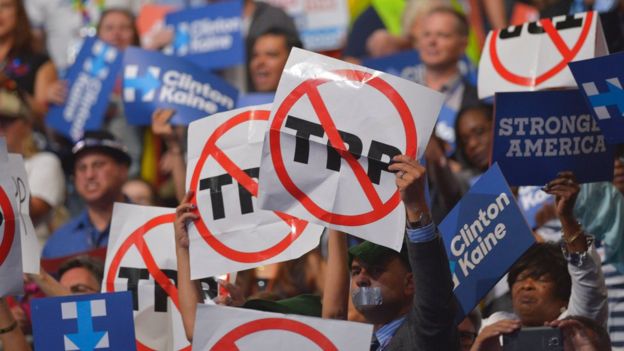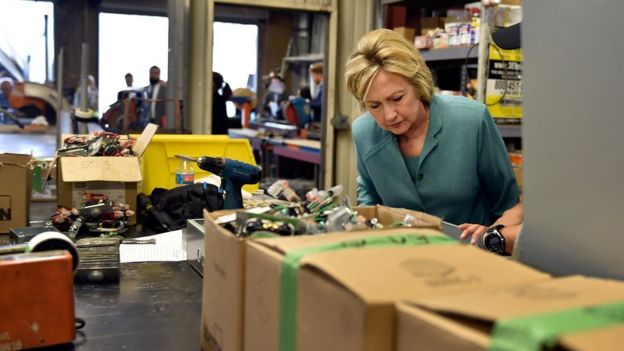
Mr Trump is focusing on cutting taxes, eliminating regulation and ending trade deals.
Mrs Clinton, on the other hand, wants to raise taxes on the wealthy, increase spending on job training and lower taxes on companies that hire more Americans.
Here are some of the ways they differ.
Taxes: Slash v spend

Trump's Economic Policy Speech, Detroit
Audio File And Fact checking
Mr Trump favours cutting taxes for everyone and reducing the number of tax brackets from seven to three.
"The rich will pay their fair share, but no one will pay so much that it undermines our ability to compete," Mr Trump said during a speech on Monday.
Mrs Clinton would keep taxes the same for most Americans but add an additional bracket for the highest earners. The income from that would be used to pay for programmes like free university education for students from low- and middle-income families.
Her campaign is calling the higher taxes on the wealthy - 4% on people who earn more than $5m - the "fair share surcharge".
| Clinton tax brackets | Trump tax brackets |
|---|---|
| Earnings under $9,275 - pay 0% | Earnings under $29,000 - pay 0% |
| $9,275 to $37,650 - pay 15% | $29,000 to $54,000 - pay 12% |
| $37,650 to $91,150 - pay 25% | $54,000 to $154,000 - pay 25% |
| $91,150 to $190,150 - pay 28% | Over $154,000 - pay 33% |
| $190,150 to $413,350 - pay 33% | |
| $413,350 to $415,050 - pay 35% | |
| $415,050 to $5,000,000 - pay 39.6% | |
| Over $5,000,000 - pay 43.6% (new bracket) |
Both candidates have proposed closing tax loopholes that typically favour the rich.
Mr Trump proposes a child care deduction that would cover the average cost of child care, while Mrs Clinton favours limiting the number of deductions taxpayers can claim at 28%.
Tax deductions allow people to subtract some of the income they are taxed on - effectively lowering which bracket they fall into. They typically favour the rich who can take more, while the 43% of Americans who currently pay no income would be unaffected by the change.
Donald Trump also proposed eliminating the estate tax or "death tax" completely. The tax only applies when a family member passes on more than $5.45m worth of assets to an individual or $10.9m to a married couple.
According to the nonpartisan Tax Policy Center, Mr Trump's plan would reduce the amount of income the government takes in by $9.5tn over the next decade. Mrs Clinton's plan would add $1.1tn in revenue over the next 10 years.
Neither candidate has proposed significant reductions in spending on public pension and healthcare programmes like social security, Medicaid and Medicare. The funding needed for those is expected to balloon over the next decade and its unclear where the money to pay for them will come from without tax increases.
An analysis performed by Tax Foundation last month found that while Mr Trump's plan would lower taxes for all Americans it would lower them most for the highest earners.
New trade deals
 GETTY IMAGES
GETTY IMAGES
Mr Trump has done his best to capitalise on the discontent around trade deals.
His economic proposal suggests renegotiating trade deals using "negotiators whose goal will be to win for America". He has not spelt out what that "win" looks like, but he has promised to step away from deals like the North American Free Trade Agreement (Nafta) if a good deal cannot be reached.
Mr Trump has also promised to get tough with countries that violate trade agreements, applying new tariffs and pursuing cases against them in the World Trade Organization. He has specifically said that he will label China a "currency manipulator".
Tariffs
Mr Trump has called for a 35% tariff on Mexican goods and a 45% tariff on Chinese goods.
That would mean a $100 television from Mexico would cost $135.
This could encourage US consumers to buy more products made in America, but it would also likely encourage Mexico to place an import tax on US goods, making it hard for US companies to sell their goods abroad. Mexico purchased $267.2bn in US goods in 2015, making it the second largest export partner for the US.
Mrs Clinton has said these tariffs will lead to a trade war making it harder for the US to compete on a global stage.
Clinton has gone back and forth on trade. She previously supported the Trans-Pacific Partnership (TPP) but has said in her campaign that she doesn't think it's the best deal for America.
Her plan focuses more on increasing production in the US by offering tax incentives to companies that build there rather than barring imports out. While she has criticised some trade deals, she hasn't ruled out signing new ones if elected.
- Renegotiate trade deals to favour the US
- Walk away from trade agreements if a good deal can't be reached
- Add tariffs on some of the America's largest trading partners including Mexico and China
Clinton on trade
- Changed her mind on TPP, which she helped negotiate
- In 2007 criticised trade deal with South Korea, then supported it as Secretary of State
- Supported Nafta but has since been critical of it
Who's hiring?
Both candidates have promised to put Americans back to work, though unemployment has hovered around a low 4.9% since the beginning of the year.
Mr Trump's employment plan focuses on encouraging more businesses to open in the US. He has suggested that investing in infrastructure, cutting the trade deficit, lowering taxes and removing regulations will make it easier for companies to hire.
 GETTY IMAGES
GETTY IMAGES
In his speech on Monday, Mr Trump focused mostly on increasing manufacturing jobs, which have declined by around 5 million since 2000. Much of that decline has been caused by improvements in technology, however, not outsourcing.
Mrs Clinton's policy for jobs growth is a little more specific. She has called for increasing jobs training - in part paid for by tax revenue from wealthier Americans. She has pushed for infrastructure spending and investment in new energy to lift the number of jobs in those sectors.
Some room for agreement
Despite their many areas of disagreement, there a few things both candidates are pushing for.
- Ending corporate inversion - or transactions where US companies move their corporate headquarters abroad to avoid US taxes
- Eliminating carried interest tax - a tax that mostly benefits hedge fund investors
- Opposing the Trans-Pacific Partnership (TPP)
Mr Trump has not addressed how he will pay for these cuts, other than saying the changes will boost the economy and that will increase the tax base.
Mrs Clinton has said most of her spending increasing will be covered by tax increases, but it is unclear if those numbers entirely match up.

Hillary's Economic Policy Speech
Detroit
Audio File and FactChecking
No comments:
Post a Comment